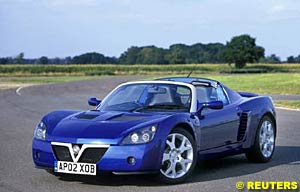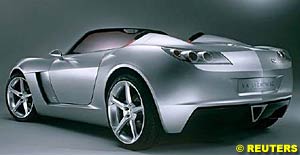

Automotive News and Reviews for the Petrolhead
Reuters Motoring Commentator
In this week's issue:
- BMW Bets on New 5 to Take it Up a Gear
- Don't Make Us Beg
It has jet-fighter style head-up displays, headlights that look round corners and uses infrared technology to keep its distance from the car in front while the driver just steers.
BMW's new 5-series saloon car, to be launched in Europe in July, may be giving the makers of auto electronics plenty to rub their hands about, but industry watchers wonder whether the company is getting too clever for its own good as it banks on the car to keep profits flat this year.
Months of falling sales of its core luxury brand and the cost of developing new models, which also include a 6-series coupe and X3 sports utility this year, have taken the shine off the Munich-based group's traditionally roaring profits, with core earnings down 18 percent in the first quarter.
Investors so far seem to be giving it the benefit of the doubt, with its stock outperforming the European autos sector index by over five percent since the start of the year.
But some analysts question whether the group, famed in the investment community for its conservative forecasts, will immediately be able to offset falling demand for its top-selling but ageing 3-series with the new 5.
"The new product story should come through in 2005, not 2004, in our view. The 3-series is ageing and could easily more than offset the 5-series upside," Credit Suisse First Boston analysts, who rate the stock "neutral", said in a recent note.
Too Clever By Half
Under design chief Chris Bangle, BMW has made a departure from its traditional conservative styling philosophy, which saw updated models being launched that looked exactly like their predecessors.
The latest 7-series, the company's large executive saloon, won a rash of criticism for its bulbous looks and its "iDrive" computer system, which used a single aluminium knob to control hundreds of different functions from the audio system to the suspension settings.
"It could be that in 30 years time people will look back and say that the 7-series and iDrive was the point where the auto industry became too clever for the consumer," said Garel Rhys, a motor industry researcher at Cardiff University in the UK.
"There is a genuine fear for the driver of touching anything in the 7-series -- you might end up heading to Uranus or start to dematerialise."
Some observers fear the 5-series, one of the group's main profit drivers, may suffer the same mistake.
But in tacit recognition that the original iDrive system might have been a technological step too far BMW says it has made the system in the new car easier to navigate.
The list of optional extras nonetheless contains a mind-boggling array of three-letter acronyms, including ACC (Active Cruise Control) which can automatically control the distance from the car in front on motorways.
The plethora of gadgets that manufacturers are increasingly packing into their cars is good news for their suppliers -- Germany's Continental, a leading electronic braking system maker, is keeping its profits on the up with such products as its core tyre business remains weaker.
The 5-series will also be the first BMW to feature an optional "head-up" display system, which projects information such as road speed or navigation instructions onto a virtual screen in the driver's line of vision. But Rhys is sceptical.
"If too much of your attention is diverted to near sight, then before you know it your brand new 5-series will be embedded in the back of a 44-tone truck."
Some weeks, there is precious little car news worth reporting.
Just to give you an idea of what I mean, over the course of the past few weeks I have heard that a brace of MINI Coopers somehow had their roofs covered with grass and plants to help promote the Chelsea Flower Show. Then there was the even more alarming tale of a new Daewoo showroom opening in Bolton and, apparently, Mitsubishi has recently appointed two new fleet sales managers. I believe one is called Paul, the other Michael. See what I mean?
Oh and did I mention that Vauxhall currently has no plans to actually build it?
The Lightning concept has been developed as part of the company's Centenary celebrations - it is 100 years since the first Vauxhall was produced at 62 Wandsworth Road, London SW8 - to help showcase its future direction and cutting-edge capabilities. Vauxhall says it will only think about building the Lightning if there is sufficient demand for it. And even then, it'll only think about it.
Such posturing is an old routine, a manufacturer's coquettish 'come-and-get-me' plea, similar to the sort of behaviour you find in pretty up-town girls who are all too aware of the effect their looks have on boys. And yet I understand Vauxhall's position over whether or not to push ahead with the VX Lightning.
In recent times, the company has had its fair share of difficulties with the (relatively) poor sales performance of the last generation Vectra, a vitally important car to the company, and the decision to close the Luton plant, home since 1905, with the loss of thousands of jobs. Troubled times, made all the more so as Vauxhall¹s range of wholesome, if a little lacklustre, models were routinely compared unfavourably to the dynamic products being launched by major rival Ford (ironically, also celebrating 100 years of motor manufacturing in 2003). The Tigra, Astra and Vectra have not quite been a match for Ford's Puma, Focus or Mondeo.
And then suddenly, as if from nowhere, Vauxhall launched the splendid VX220 sports roadster in 2000. In fairness, Ford has nothing like this little tearaway in its range. Unashamedly based on the highly successful Lotus Elise, the VX220 certainly set the cat amongst the pigeons. Lotus cognoscenti were a little perplexed to discover that the same people who built their beloved Elise could have had a hand in this subtly modified interloper (Lotus builds the VX220 under licence from Vauxhall). Meanwhile some sections of the specialist press, seemingly entrenched in a phase of general Vauxhall bashing, appeared flustered by this rear-driven sportscar with its sharp looks, perma-grin handling and blistering performance (0-60 in just 5.6 seconds). Nice idea, shame about the badge, it seemed. Undaunted, Vauxhall launched a turbo-charged version of the VX earlier this year. It develops 200 bhp, weighs little more than an unused tissue and is even quicker than the original version, reaching 60 mph in less than five seconds and trouncing any standard Elise in a straight line (all for a shade over twenty-five grand).
Vauxhall simply has to build this car, and here's why. First of all, it looks absolutely brilliant. Secondly, an extra 40 bhp in an even lighter chassis than the VX220 should ensure the Lightning goes like proper stink. And finally, this car is the fruit of British labour. Its design direction was overseen by two Brits Simon Cox and Martin Smith; the design development was undertaken at General Motors' advanced design studio in Coventry; it wears a Vauxhall badge, which is a British brand.
So brace yourselves, but it would seem that the best news of all is that this stunning new car is British. Now this fact alone makes it well worth reporting.
![]() BMW Bets on New 5 to Take it Up a Gear
BMW Bets on New 5 to Take it Up a Gear
![]() Don't Make Us Beg
Don't Make Us Beg
 So, in the scheme of things, word of an exciting new Vauxhall sports roadster is hot news indeed. Take a long look at the VX Lightning while words are useful to help describe this thrilling-looking car's specification, only these images can truly complete the picture. It features lightweight independent suspension all round, 19" wheels at the front, 20" at the rear, and is powered by a supercharged version of Vauxhall's all-alloy 2.2 ECOTEC engine, offering something in the region of 240 bhp. It is rear-wheel driven, through a six-speed manual gearbox, and boasts a near perfect 50:50 weight distribution to help ensure its handling and road-holding are the measure of its spine-tingling looks.
So, in the scheme of things, word of an exciting new Vauxhall sports roadster is hot news indeed. Take a long look at the VX Lightning while words are useful to help describe this thrilling-looking car's specification, only these images can truly complete the picture. It features lightweight independent suspension all round, 19" wheels at the front, 20" at the rear, and is powered by a supercharged version of Vauxhall's all-alloy 2.2 ECOTEC engine, offering something in the region of 240 bhp. It is rear-wheel driven, through a six-speed manual gearbox, and boasts a near perfect 50:50 weight distribution to help ensure its handling and road-holding are the measure of its spine-tingling looks.
 But here is the dilemma Vauxhall faces. Finally its pocket rocket seems to be receiving the acclaim it deserves but boy, does it need it. As a result of what seems to be little more than badge snobbery, Vauxhall failed to find many customers for the original VX220, although orders for the turbo-charged version have been more encouraging, and this is undoubtedly a factor in why it is hedging its bets with the Lightning concept. So, if we want Vauxhall to get on and build it (and we do), we must all either: (a) buy a VX220 Turbo first; or (b) write to Vauxhall demanding to know where to send our Lightning deposits.
But here is the dilemma Vauxhall faces. Finally its pocket rocket seems to be receiving the acclaim it deserves but boy, does it need it. As a result of what seems to be little more than badge snobbery, Vauxhall failed to find many customers for the original VX220, although orders for the turbo-charged version have been more encouraging, and this is undoubtedly a factor in why it is hedging its bets with the Lightning concept. So, if we want Vauxhall to get on and build it (and we do), we must all either: (a) buy a VX220 Turbo first; or (b) write to Vauxhall demanding to know where to send our Lightning deposits.
© 1995-2005 Kaizar.Com, Inc. . This service is provided under the Atlas F1 terms and conditions.
|
Volume 9, Issue 23
Atlas F1 Exclusive
Keeping Track: Mike Doodson Turns 500
Ann Bradshaw: View from the Paddock
Monaco GP Review
2003 Monaco GP Review
Crossing Over the Jordan
The Forgotten Men
Stats Center
Qualifying Differentials
SuperStats
Charts Center
Columns
Season Strokes
On the Road
Elsewhere in Racing
The Weekly Grapevine
> Homepage |